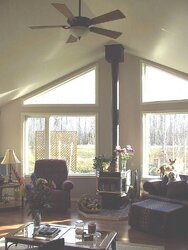Bozlee,
Need your response to the following in order to help you out because I don’t believe the Osburn is your problem
Do you have a Jenn-Air cook range?
NO
If not, do you have a vent-less exhaust over the cooking stove?
YES
If not, does the vent exhaust out the attic or the roof?
Does the clothes dryer, hot water heater, toilet stacks, furnace, etc all exhaust out the roof, and not into the attic?
ALL THESE ITEMS VENT TO THE OUTSIDE
Do you ever have inside condensation on the glass inside your house?
YES! WE HAVE AN HRV UNIT AND WHEN I HAVE MOISTURE BUILD UP I RUN THE HRV TO CLEAR THE WINDOWS. IF I LEAVE THE HRV RUNNING ALL THE TIME THERE IS NEVER ANY CONDENSATION ON THE GLASS. I DO NOT RUN THE HRV WHEN THE STOVE IS BURNING.
If so, in what room(s)?
WHEN THE OUTSIDE TEMPS DROP BELOW -10 CELCIUS ALL MY WINDOWS HAVE A WATER/ICE BUILD UP ALONG THE BOTTOM AT THE WINDOW LEDGE....you are the first person to ever ask this question
Does Canada's building code require 6 mil plastic vapor barrier?
YES BUT I THINK IT'S A THICKER MIL
Has anyone ever checked the attic to ensure that a vapor barrier was installed?
WE HAVE VAULTED CEILLINGS AND THEREFOR NO ATTIC...I WAS HERE WHEN THE CIELING WAS INSULATED AND YES THERE IS A VAPOR BARRIER
Has the house ever had an attic fan?
NO
Am I correct in assuming that your “chimney” height is over 18’ ?
FLOOR TO CEILING IS 13 FEET...CHIMNEY IS 4 FEET ABOVE THE ROOF LINE WE ALSO HAVE A FOUR INCH COLD AIR RETURN FROM OUTSIDE INTO THE STOVE
If that height is correct then a loose door is definitely
not your grease problem.
YOUR QUESTION ABOUT THE CONDENSATION ON THE GLASS HAS MY ATTENTION ! YOU CLEARLY SOUND LIKE YOU KNOW SOMETHING ABOUT THIS SUBJECT AND I DO APPRECIATE THE TIME YOU TOOK TO REPSOND TO ME. I WILL TAKE ANY ADVICE THAT I CAN GET ON THIS PROBLEM. I AM WAITING WITH BAITED BREATH TO HEAR BACK FROM YOU. FEEL FREE TO E MAIL ME DIRECTLY. IF YOU CAN SOLVE MY GREASE PROBLEM I WILL MAKE CERTAIN OUR NEXT BORN POLAR BEAR IS NAMED AFTER YOU

My heater has
never had gaskets. It does not need such because what little air gets by is insufficient to maintain combustion within the heater. My "chimney" is only 13', add another 5' & I would have to tie down my grandkids when I added wood as the draft would be that strong. :lol:
A strong draft eliminates the possibility of smoke coming out the heater during the run stage.
EXCEPT THE OCCASIONAL PUFF WHEN I OPENED THE DOOR TO RE LOAD WOOD WE HAVE NEVER SEEN ANY SMOKE COMING OUT OF THE STOVE.
As for your neighbor’s experience consider this possibility.
He had just got the heater adjusted to burn his “
seasoned” firewood when he decided to go visiting. But when he left the heater was,
in reality, just finishing expelling the last of the moisture in his fire wood & then getting
serious about combustion. Since your neighbor had been burning such “
seasoned” firewood he had inadvertently built up creosote in his “chimney”. Since the heater had boiled off the water content in the fire wood it now had more than more enough air input to get the heater temp up to the creosote’s flash point &, as they say, his house became toast.
WE ALWAYS BURN WELL SEASONED FIREWOOD..USUALLY TAMARAC. ARE YOU SAYING WELL SEASONED WOOD IS NOT GOOD TO BURN?
Heaters
seldom burn down houses. Chimneys do it all the time. ;-)
Dave



